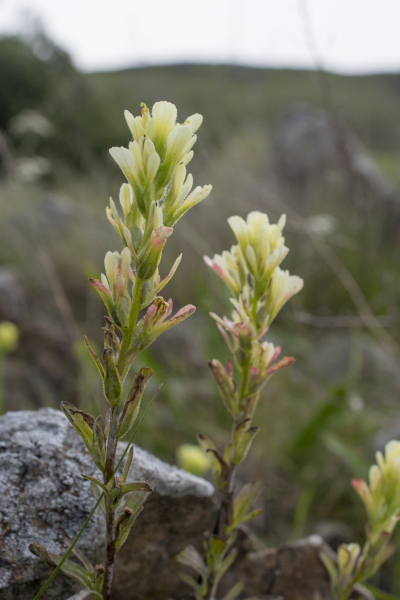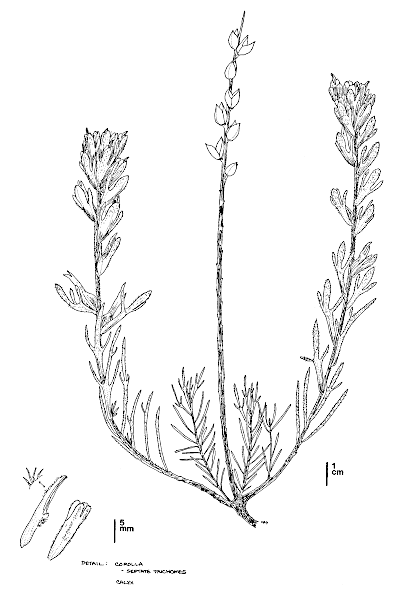(Castilleja affinis subsp. neglecta)
 Castilleja affinis subsp. neglecta. Photo by Jeb Bjerke.
Castilleja affinis subsp. neglecta. Photo by Jeb Bjerke.
 Castilleja affinis subsp. neglecta. CDFW illustration by Mary Ann Showers. (Click to enlarge)
Castilleja affinis subsp. neglecta. CDFW illustration by Mary Ann Showers. (Click to enlarge)
Tiburon Paintbrush (Castilleja affinis subsp. neglecta) is a California threatened plant species, which means that killing or possessing this plant is prohibited by the California Endangered Species Act (CESA). This species is also listed as endangered under the federal Endangered Species Act. Tiburon paintbrush is a member of the broomrape family (Orobanchanceae) and is a semi-woody perennial with erect, 15 to 60 cm (0.5 to 2 ft) tall, branched stems, and is covered in bristly hairs. The flowers are yellow to red in color, with yellowish bracts that are sometimes red-tipped. Tiburon paintbrush blooms from April to June and is thought to be pollinated by hummingbirds, but may be insect pollinated as well. Tiburon paintbrush is a hemiparasite on other angiosperms (flowering plants), meaning it absorbs a portion of its required water and minerals from the roots of other plants in the soil. Field studies suggest it utilizes a variety of host plants.
Tiburon paintbrush occurs in serpentine bunchgrass communities, typically on west or north-facing slopes. The distribution of Tiburon paintbrush has never been widespread. At the time of this web page posting, the California Natural Diversity Database reports seven occurrences: four in Marin County, one in Napa County, and two in Santa Clara County. Three of the populations in Marin County occur on the Tiburon Peninsula. Surveys indicate a large degree of fluctuation in plant numbers per year within each population. The populations are small, with numbers ranging from less than 100 plants to a little over 1,000. Tiburon paintbrush grows on open, rocky, serpentine slopes at between 75 and 400 m (250 and 1,300 ft) in elevation. Associated species include California gilia (Gilia achilleifolia subsp. multicaulis), California poppy (Eschscholzia californica), dwarf plantain (Plantago erecta), purple needlegrass (Stipa pulchra), Tiburon buckwheat (Eriogonum luteolum var. caninum), and serpentine reedgrass (Calamagrostis ophitidus). It also grows in association with three other state- and/or federally-listed species: Tiburon mariposa lily (Calochortus tiburonensis), Marin western flax (Hesperolinon congestum), and Santa Clara Valley dudleya (Dudleya abramsii subsp. setchellii).
Tiburon paintbrush is currently threatened by urban development, mining, recreational activities, non-native plants, and random events such as fire and drought. Since the time of listing, new information suggests that climate change and nitrogen deposition exacerbate existing threats to the species by increasing the rate of invasion by non-native species and increasing the frequency of fire and drought. The U.S. Fish and Wildlife Service released a Recovery Plan for Serpentine Soil Species of the San Francisco Bay Area (PDF) in 1998, which includes the Tiburon paintbrush. Habitat protection and management is a key element in the recovery of Tiburon paintbrush as well as the recovery of other species that are only found on serpentine soils. In order to ensure the continued existence of Tiburon paintbrush, natural populations should be protected and managed in perpetuity. Tiburon paintbrush seeds are being kept in long-term storage at the U.C. Berkeley Botanical Garden to protect the species from current and future threats of extinction.
CDFW may issue permits for Tiburon paintbrush pursuant to CESA, and you can learn more about the California laws protecting Tiburon paintbrush and other California native plants. Populations of Tiburon paintbrush occur in CDFW’s Bay Delta Region. More information is also available from the U.S. Fish and Wildlife Service Species Profile for Tiburon paintbrush
Updated 10/24/2018